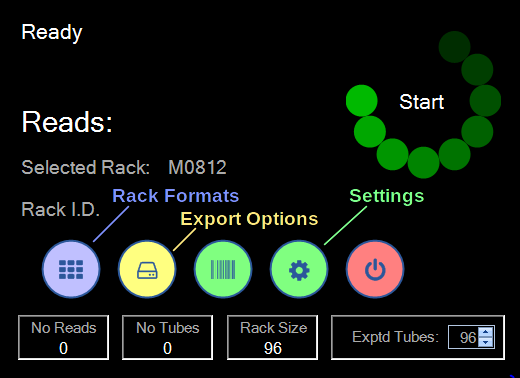A Java client for accessing a Thermo Scientific VisionMate scanner via TCP/IP.
- Scanner model AB-1850, software v3.2.1.10: works as is
- Scanner model 312800, software v4.0.4.1: works with patches. There are bugs in this version of the VisionMate software. Thermo Fisher has provided these two patches, which are required in order for this library to communicate with the scanner software. Unfortunately, the patches have not yet been included in an official release. Installation instructions are included in the archives.
mvn clean install
This will run unit tests, and compile the project, creating two jars
- visionmate-client-<version>.jar
- visionmate-client-<version>-jar-with-dependencies.jar
A mock server class is included to allow testing without interacting with a real server. The mock server is made to imitate the real server as much as possible. Methods are provided to manipulate its current state and data before issuing commands to it over TCP/IP.
java -jar <jar-with-dependencies> <server-ip> <server-port>
A small CLI application is included for testing with a real server. Run it and type 'help' for a list of commands.
mvn test
The unit tests make use of the mock server, so that a real server is not required.
-
Choose the release type according to semantic versioning:
- "patch" if there are only fixes
- "minor" for most updates that add features
- "major" for milestone/huge updates
-
Release
git checkout master git pull ./release.sh <release_type>
Server Setup - V3 VisionMate Software
- Enable the TCP/IP server: Open the VisionMate software and go to Export > Enable TCP/IP Server
- Display the TCP/IP tabs: Config > Show TCP/IP Tab
- Set a suffix character (TCP/IP Server tab). A suffix character marks the end of response data and is required for the client to function correctly. It is ideal to use a non-printable character to ensure that it is not found in barcodes or other data that the server may send. The suggested character is ASCII control character 3 (the end of text character), which can be chosen by entering '[3]'
- Use a fixed rack ID: Rack ID > Use Fixed ID
- Enable auto-login (optional) and ensure that settings are saved when the software is restarted
- Options > Auto Login > As Admin
- Options > Use Global Settings for all Users
It is recommended to leave other settings at their default, but if you'd like to change anything else, ensure that the option is supported in the client (see below).
Server Setup - V4 VisionMate Software
- Enable the TCP/IP server: Export Options > TCP Server (a checkmark should appear to indicate it is enabled)
- Set a suffix character: Export Options > TCP Server > Config > Data Field Suffix. The suggested character is ASCII control character 3 (the end of text character), which can be chosen by entering '[3]'
- Add a rack type: You will need a rack with tubes in it in order to set this up as there is no option to manually define a rack type. Click Settings > RAD and follow the on-screen instructions to scan the rack. Name it in the format MRRCC, replacing "RR" with the number of rows, and "CC" with the number of columns. e.g. "M0812" for a rack with 8 rows and 12 columns. Ensure that this rack type is selected in Rack Formats
It is recommended to leave other settings at their default, but if you'd like to change anything else, ensure that the option is supported in the client (see below).
Client Setup
A ServerConfig object holds configuration settings that MUST match the server's configuration. It is recommended to use the default settings for everything EXCEPT for the suffix character. The default and recommended suffix character in the client is control character 3, as noted above.
The following operations are available via the VisionMateClient
- get status
- reset status
- get current product
- set current product
- get scan data
- get last error
There are also convenience methods for monitoring status updates and getting scan data when a fresh scan is completed.
try (VisionMateClient scanner = new VisionMateClient(<host-ip> <port>) {
scanner.connect();
// expect a matrix box with 8 rows and 12 columns
scanner.setCurrentProduct(Manufacturer.MATRIX, 8, 12);
// reset status, so we can observe status updates to find when a new scan has occurred
scanner.resetStatus();
System.out.println("Scan the rack now");
Scan scan = scanner.waitForScan();
if (scan == null) {
// timed out; no rack was scanned
}
else {
// rack was scanned
}
}
